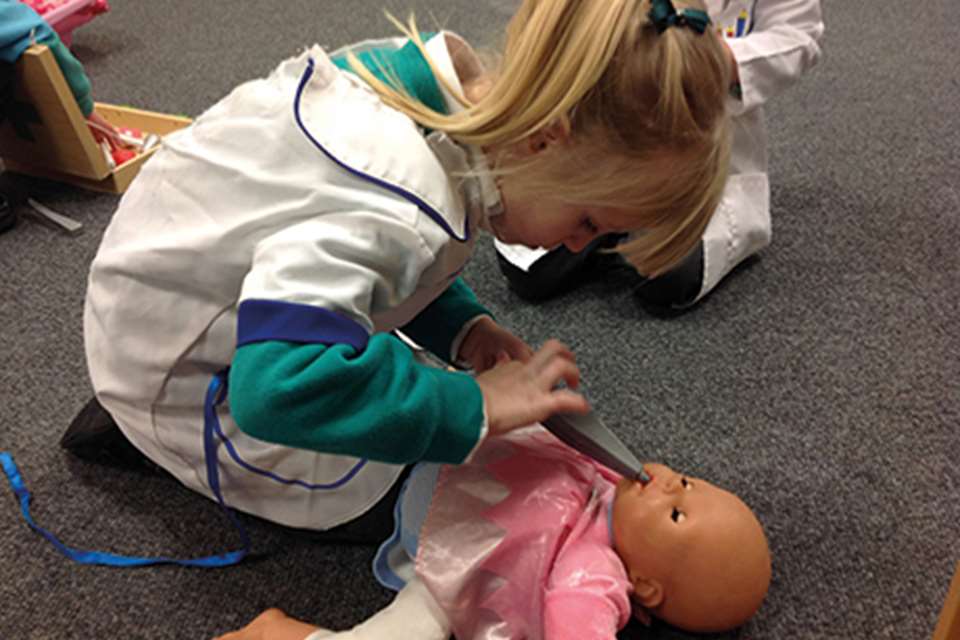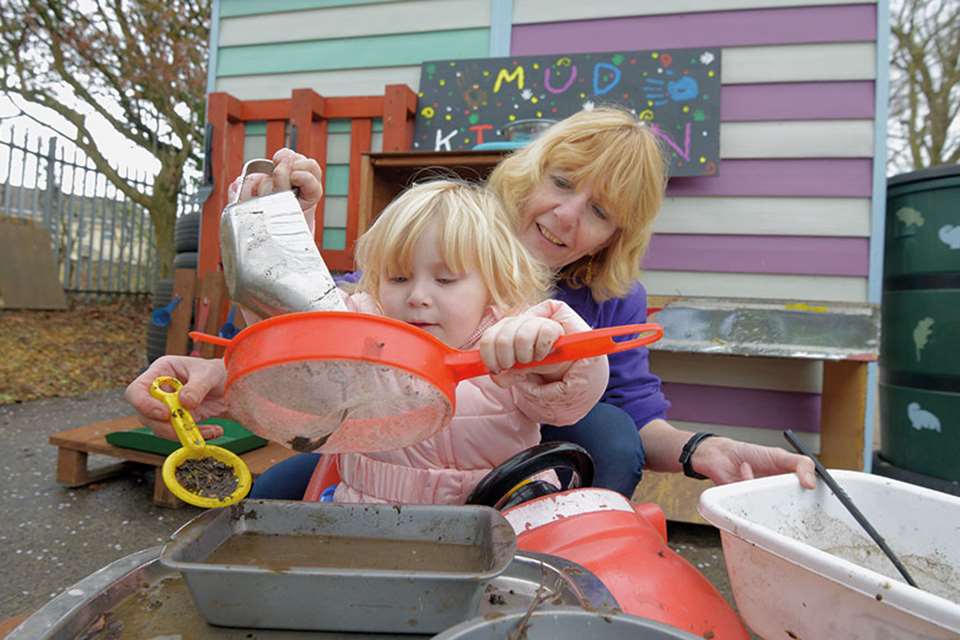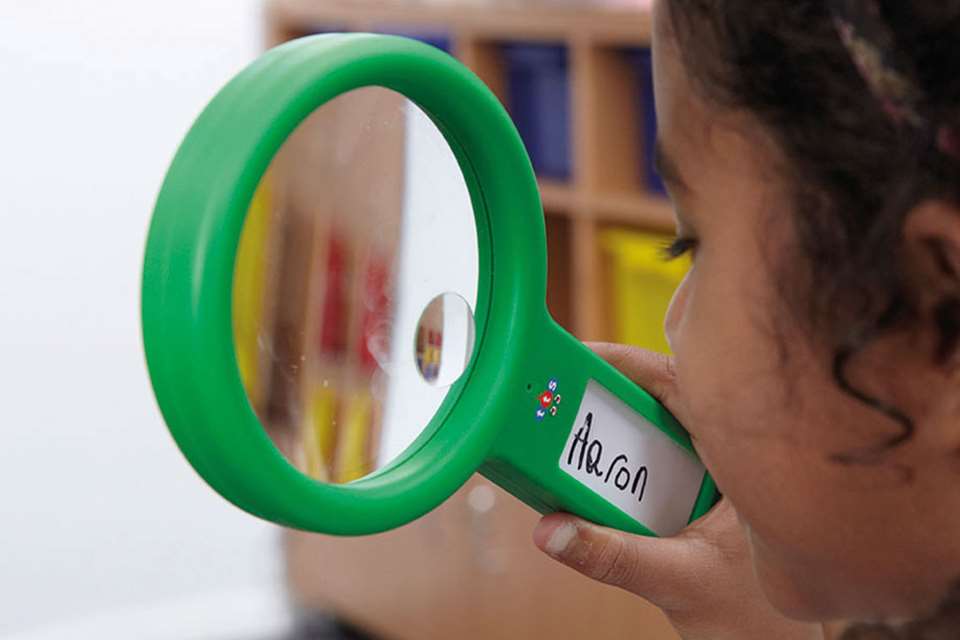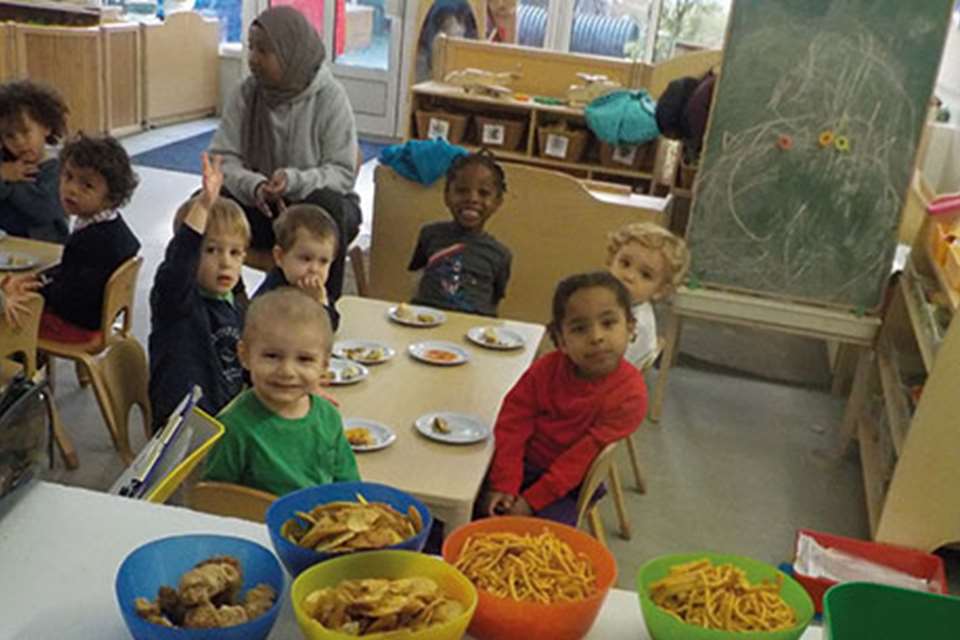Enabling Environments: Collections - On the table
Nicole Weinstein
Monday, January 22, 2018
In the first of a new series on self-care, Nicole Weinstein finds out how carefully chosen crockery and chairs can enhance the mealtime experience

Download the PDF of Collections - On the table
Early years practitioners have a vital role to play in developing healthy eating patterns in young children and advising parents on their children’s diets. This means reflecting not just on what children eat, but also on the utensils and crockery that they use. When it comes to weaning, parents will want to know about age-appropriate cutlery and cups, as well as when and how to introduce solids (see box), while in the nursery, the challenge is to find resources that make mealtimes a pleasurable and social experience for all children.
White melamine crockery, chosen for its practicality and the fact that it showcases the vibrant colours of the foods, is used by children at the Yellow Dot Nursery group of 12 settings in Hampshire.
Director Jane Dyke explains, ‘We follow a Froebelian approach to learning, we try to use natural products and eliminate plastic where realistically possible. So, a few years ago, we decided to replace our multi-coloured, plastic Ikea plates and bowls because we felt that the colour of the plastic plates was obscuring the natural colour of the food. On a white plate, the fabulous colours of the food stand out, which makes it aesthetically pleasing, encourages discussions around the table as well as encouraging the children to eat.
‘Initially, we trialled white china crockery, but not only was it heavy when stacked but with wear and tear, the glaze wore off and it became chipped in places, which wasn’t the desired effect. So, we then sourced white melamine plates and bowls with blue and yellow borders.
‘The yellow-bordered plates denote an allergy or preference, so this helps us to keep the children safe. They are very practical – they don’t break or stain. They are light-weight and they go through an industrial-style dishwasher.
SENSE OF COMMUNITY
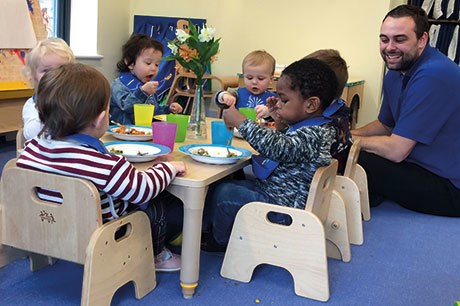
The babies, once they are able to sit properly, sit around a horseshoe-shaped table with a team member in the middle of them – an arrangement, says Ms Dyke, that ‘creates a sense of community’ and enables the team to interact and assist when needed.
‘The children each have a Mealtime Chair from Community Playthings,’ she adds. ‘This is a small feeding chair that allows them to eat independently at the right height for the table. The team bottle-feed babies who are unable to sit unaided, in their arms.
‘For the younger toddlers, aged around 18 months, there is a version of the Rosti plate with a raised edge, which is useful for children who are beginning to learn to feed themselves with a fork and spoon.
‘We introduce a knife at the age of around two years. The children then sit in the Woodcrest chairs, also from Community Playthings, which are wooden, ergonomic chairs, supporting good posture.
‘On all of our tables, even in the Baby Room, there is a glass vase with a real flower in the middle of the table. This brings a form of natural beauty to the dining experience and we encourage our cooks to go into the rooms so the children are familiar with the person who has worked hard to cook their meal.
‘We encourage parents to wean their children from six months and, in partnership with parents, finger food – sandwiches, crackers, cheese, chopped fruit and vegetables – is offered at high tea.
‘Babies and toddlers use free-flowing Tommy Tippee cups with lids at first and we then take the lids off. They then move on to cups with no handles from Ikea.’
RESOURCES
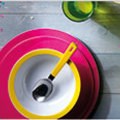 Melamine crockery: Rosti Mepal’s Dish Wave – deep plate/breakfast plate/bowl, circa 2.29 euros each, at www.rostimepal-markenshop.de.
Melamine crockery: Rosti Mepal’s Dish Wave – deep plate/breakfast plate/bowl, circa 2.29 euros each, at www.rostimepal-markenshop.de.
Community Playthings’ Mealtime chairs, from £100, come in two sizes: use the 20cm chair for ages six to 24 months and the 25cm chair for ages 12-24 months. Available at https://www.communityplaythings.co.uk/products/baby-room/toddler-chairs/mealtime-chairs.
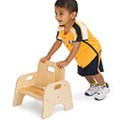 Community Playthings’ Woodcrest chairs, from £77, come in two sizes: use the 21cm chair for ages 18 months to three years and the 26cm chair for ages two to four years. Available at www.communityplaythings.co.uk/products/classroom-furniture/chairs/j708.
Community Playthings’ Woodcrest chairs, from £77, come in two sizes: use the 21cm chair for ages 18 months to three years and the 26cm chair for ages two to four years. Available at www.communityplaythings.co.uk/products/classroom-furniture/chairs/j708.
Doidy cups (£3.80-£10.26) help children get used to an open cup. They have a slanted top so the child can see the liquid sooner and can be held easily. See www.bickiepegs.com/product/doidy-cup.
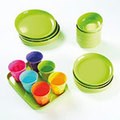 For an entire place setting (plates, bowls, tumblers, knives, forks, spoons for four children), try Place settings – Swirls x4, £28, from www.earlyyearsdirect.com.
For an entire place setting (plates, bowls, tumblers, knives, forks, spoons for four children), try Place settings – Swirls x4, £28, from www.earlyyearsdirect.com.
The Melamine Dinnerware Range, from £3.99 for a dining tray, and Tommee Tippee 3 in 1 Nursery Cups 12pk, £27.95, are both available at www.tts-group.co.uk.
AGE-APPROPRIATE UTENSILS
 Catherine Lippe, one of the registered nutrition professionals from the Early Years Nutrition Partnership, provides the latest advice on introducing solids and age-appropriate feeding equipment:
Catherine Lippe, one of the registered nutrition professionals from the Early Years Nutrition Partnership, provides the latest advice on introducing solids and age-appropriate feeding equipment:
Q When should children start using a cup, a spoon, a fork and a knife?
A It’s helpful to expose babies to age-appropriate cups, bowls, plates and cutlery around the same time you start introducing them to solid foods (typically around six months). Learning how to use a fork and spoon is something that will take time. By offering them regularly at the start of weaning, babies will have the opportunity to explore and use these new utensils.
Q What age should infants start using a high chair or equivalent?
A Whenever you offer a baby any food (other than milk), they should always be in an upright position, with a straight back, to avoid the risk of choking.
You could use a high chair to seat them in this position, or if they are still quite small and the high chair doesn’t offer enough support, you could try rolling up a few towels or using cushions to support them. Infant car seats and baby bouncers tend to result in a much more reclined position and are not recommended as seats for feeding a baby solid foods.
Q How about finger food? When do you advise children start eating with their fingers?
A Finger food can be introduced from around six months if the baby is ready. Some babies will be ready and more interested in finger food than others, so my advice would be to start offering it around six to seven months and let them explore the foods. Follow their lead. They’ll soon let you know if they enjoy the finger food and self-feeding approach or if they would prefer to be spoon fed by you. If they are not interested in finger food, try again another day or the following week.
If you do offer finger food, aim for a strip of food about the size of an adult’s index finger and ensure that the texture is soft enough for baby to bite through with their gums, but not so soft that it falls to pieces as soon as they pick it up.
Q And what about spoon feeding? Any guidance around this?
A Spoon feeding can be introduced as soon as you start offering solid food (ideally around six months). Depending on age and developmental stage, it usually starts with smooth, runny purées which will gradually become thicker and lumpier as a baby grows.
As a baby becomes more confident with solid food and gets used to pushing the food around in their mouth, you can progress onto lumpier textures around seven months and continue adjusting the texture until the food begins to resemble the appearance of typical ‘family’ food. The aim is to reach this point by around 10-12 months.
Q What type of cups should we use?
A In order to promote dental health and appropriate speech development, it is recommended to offer drinks in a non-valved, free-flow cup from six to 12 months and to stop using baby bottles for any drink by 12 months.
With this recommendation in mind, it is helpful to encourage the use of a free-flow beaker or small open-top cup around the time of weaning to allow the baby to learn the skill of sipping. If it is free-flow, the water will freely dribble out when you tip the beaker upside down. Non-spill, valved and any-way-up cups require the baby to suck rather than learn to sip.
MORE INFORMATION
The Early Years Nutrition Partnership, www.eynpartnership.org
www.actionforchildren.org.uk/resources-and-publications/information-guides/eat-better-start-better



